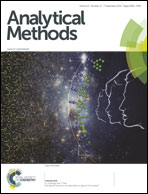A fluorescent aptasensor for sensitive detection of human hepatocellular carcinoma SMMC-7721 cells based on graphene oxide
Abstract
In this work, we reported a simple, rapid and sensitive fluorescence method for the direct detection of cancer cells using a graphene oxide (GO)-based aptasensor. This method took advantage of the exceptional quenching capability of GO for dye-labelled aptamers, and an aptamer was employed as the molecular recognition element. As proof of concept, an aptamer sequence was selected using a cell-based SELEX strategy in our laboratory for human liver cancer cell line SMMC-7721 with high specificity and high affinity, which was applied in this method. Samples with the target cells show high fluorescence intensity, while non-target samples still showed low fluorescence intensity. This GO-based aptasensor exhibited high sensitivity and specificity with a detection limit of 200 SMMC-7721 cells in 200 μL binding buffer. In addition, our strategy can directly detect target cells without washing and separation. Furthermore, the future design of detectors for other cancer cells only requires changing the recognition element for the target cell. More importantly, flow cytometry was used for the specific recognition of target cells from a mixture of cells in fetal bovine serum to demonstrate the potential application of this method for medical diagnostics.


 Please wait while we load your content...
Please wait while we load your content...